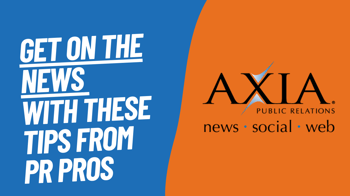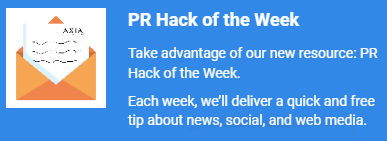Top PR Pros Share Their Tips for Earning U.S. Media Coverage
By Axia Public RelationsApril 25, 2023
We asked some of the nation’s most successful media relations practitioners to share their best practices.

Earning media coverage is becoming more and more challenging and competitive for public relations and corporate communications professionals. That’s because traditional newsrooms are shrinking, and positive media coverage is now more precious than ever before. While the best PR pros are still getting ink for their employers and clients, it’s always helpful to uplevel your game.
Audio: Listen to this article.
To that end, we asked some of the most successful media relations professionals to share their top tips for media relations and earning media coverage, which we’ve organized into five categories:
- Planning and Preparation
- Relationship Building
- Messaging
- Pitching
- Following up
In no particular order, here’s what our expert respondents recommend. We hope you find these tips helpful as you pursue the joy of seeing your employer or client in the news from your efforts and facilitation.
Planning and Preparation
“You definitely want to keep your client's [online] profiles updated. It makes a big difference. Add relevant quotes, and make it a point to update them as often as needed. You also want to add published links. I find Qwoted to be very supportive, so take advantage of their 1:1 calls if you need any help.” – Julie Khanna
“One of my favorite tips for my fellow PR pros, and something we try to convey with our clients regularly, is to never discount the power of a niche outlet or trade publication. While everyone is chasing after the Tier 1 media, there's also a great deal of opportunity with smaller digital publications, podcasts, and more who are hungry for content and have a highly targeted audience that can be a very effective way to reach your client's ideal clients or customers. In one example, one of our clients was featured in a magazine that was targeted to women in their (highly male-dominated) industry. While some PR pros may have turned their noses up at a seemingly "small" media hit, it actually ended up landing her her biggest investor for their initial fundraise. Had she turned away that opportunity waiting for Tier 1 media to come knocking, she never would have gotten in front of that investor!” – Aquila Mendez-Valdez
“As core media relations becomes more difficult every day, particularly for general/business press (e.g., The New York Times, Wall Street Journal, etc.), it is imperative that PR professionals hedge their bets with clients before they even start pitching. This means threading the needle with client expectations — not overpromising coverage results and not being overly pessimistic either. Unless you are working with a difficult client, realistic expectation paired with optimistic goals and planning usually helps most clients understand what to expect from various PR campaigns/narratives. If you can do this, it will set you up for success before you even send the first pitch, as you and your client will have a shared vision for the outcomes, a vision that will put you in a better place emotionally when results do or don’t come in from your outreach efforts.” – Scott Rosenblum
Relationship building
“Research and identify media outlets that are best suited to your story. Connect with journalists who cover stories related to your client's product or service.” – Jae Monique
“If you find you’re struggling to break through the noise, try a new tactic: ask the reporter what they need. You may find the reporter is looking for someone to provide a contradiction or propose a new tactic. It’s easier to work with your source bench if you better understand what the reporter is still looking for as they write their piece.” – Carrie Winans
“Offer to help: One thing I have found helpful for my career has been to always mention that my client would love to be helpful if the journalist has other pieces coming up. Often, these writers will remember that and come back to me for help with other articles they are writing where my client(s) can be helpful.” – Joe Karasin
“It’s all about relationships. You want the people you are pitching just as invested in the topic as you or your client is, so treat them with dignity and respect and get them interested in what you’re doing. Establish a relationship with reporters by being a valuable asset to them and helping them out when you can if they have a tight deadline or sending interesting news that might appeal to them on a personal level because you did your research on them and maybe even keep up with them on social media. It's all about personal connections.” – Chelsea Kershaw
“Think about ways you can help the reporter — even if it doesn’t benefit you. Any time a reporter comes to me with a source request that I can’t fill, I do my best to connect them with someone else who can help — a former colleague, client, or even another agency or freelancer. Chances are, that reporter will remember how you helped them, and it will come back to you tenfold.” – Abbie Sheridan
Messaging
“Craft compelling and relevant content. Distribute information into brief yet informative messages that will grab the attention of time-pressed journalists and editors.” – Jae Monique
“Speed wins: If you're doing responsive PR (Qwoted, HARO, [ProNet], etc.), being the first pitch helps. Also, responding to follow-ups quickly also goes a long way. I can't tell you the number of times I have been thanked by reporters for being quick to respond to their questions.” – Joe Karasin
“One of the best ways to get media coverage for my clients is to keep it natural and conversational. Once you get a quote for your client, there is a higher likely for that reporter to get back to you for another quote.” – Samrudha Salvi
“Make sure you are responding to the reporters' query promptly and completely. If you are one of the first people to respond to their request and answer all their questions. It's more likely they will use your response in their article. Make sure you are giving quality answers though; don't just rush to be first. If you wait too close to the deadline, you run the risk of the reporter closing their query because they have received enough responses or already found a different source.” – Gaby Lask
“My number one tip for Qwoted is to submit your response as quick as you can and always before the deadline. I stress to my clients the importance of speed for winning queries, and I often give them a deadline that is before the actual deadline listed by the reporter.” – Melanie Parncutt
Pitching
“Be relevant: A relevant pitch is important to both the client and the journalist. If your client is in manufacturing and there is a request for a banking expert, it doesn't help your client or the reporter to have your pitch submitted. In fact, it can often do harm to your reputation as a PR representative.” – Joe Karasin
“90% or so of the queries from reporters on [ProfNet, HARO, and Qwoted] are highly specific. Unless you can pitch them with the specific commentary they are seeking in a timely fashion, it will likely be a waste of your time to pitch a general or tangential response to them. This understanding is even more relevant when it involves queries from reporters at top tier publications that receive a lot of pitches as the competition will definitely give the reporters what they are looking for.” – Scott Rosenblum
“Keep AI out of it. It's been observed that people use a lot of AI content to answer some questions. But the same question will get an almost identical answer from AI, so you can never differentiate your answer or quote from others. I know many agencies which do HARO solely on AI. But the success rate is quite low for them.” – Samrudha Salvi
“When creating pitches, make sure you're only sending the most relevant information the reporter will need. I always try to send the shortest and most concise pitch I can. Reporters tend to spend a few seconds reading a subject line and pitch before moving on, so it's best to keep it short and sweet.” – Maria Amezquita
“My favorite tip is to cite previous coverage that the reporter has written in your pitch to show you've done your research. Reporters rightfully complain about irrelevant pitches. Show your reasoning on why you think they'd be a good fit!” – anonymous contributor
“Create what I call ‘silver platter’ pitches. Give the journalist everything they need to tell the story. Make it easy for them to say ‘yes.’ So that means provide a link (or two) to quality data or research on your story angle, and give them the names and contact information of interview subjects who are ready and waiting for them to call.” – Bob Wiltfong
In addition to these tips, our PR firm team also recommends submitting the responses as quickly as possible with the information they need to write the article based on your submission. You can pitch back to them using the same language they used in their query. And make sure to save your response in your Google Drive shared accounts folder for future reference and access. It’s common to see the same or similar query, and then you can simply revise what you’ve used previously instead of starting from scratch.
Following up
“Following up is your most powerful tool when pitching the media. You have no idea what a reporter has on their plate or what story they may be working on, which is only one reason to follow up with reporters.” – Marjorie Comer
“In our experience, follow-ups are critical to a successful media relations program. According to research, most PR pros only follow up once, and generally, they’re only asking the loathed, “Did you get my press release?” Don’t be that guy. When you follow up, follow up with value. Add value to the conversation and use that value to push your story across the finish line. This might be a photo or visual, another source, or additional insight. Following up is so important that we celebrate them at our PR agency. We know that if we follow up professionally and with a helpful tone of providing additional information and value, we will increase our success in pitching.” – Jason Mudd
“Don’t be afraid to use the phone! Be ready to leave a brief message that furthers the pitch and entices the reporter to call back. And then be ready to deliver on that pitch. Reporters and editors are busy. View your follow-up as helpful to them in doing their job.” – Patrick McSweeney
If you enjoyed these media relations best practices, please consider opting into our PR Hack of the Week where we share quick tips to improve your organization’s public relations and corporate communications, or watch our media relations best practices conversation (video).
Photo by RODNAE Productions
Topics: media relations, earned media, news media


Comment on This Article